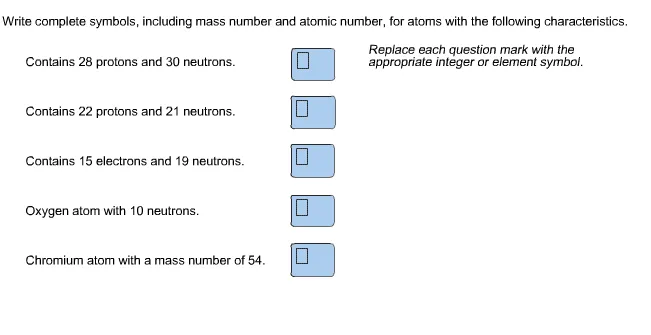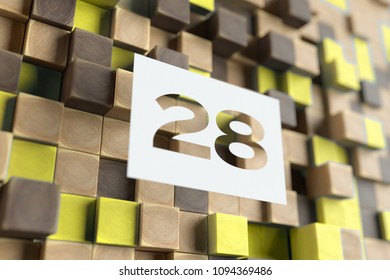- How to calculate the number of protons, neutrons and electrons in an atom of an element - How to make a model of an atom - How to draw an atom (video) - How to read an electron configuration chart - A list of who discovered each element. The information on this site has been compiled from a number.
- For Iron (atomic number 26) there is something happening to the pattern after 41 neutrons. For Cobalt (atomic number 27) and Nickel (atomic number 28) there are some things happening to the pattern after 30 neutrons and 39 neutrons. For the shell containing the 3rd through 6th nucleons the only possible special number is 4.
- 28 Ni Nickel 58.6934. Atomic Number: 28. Atomic Weight: 58.6934. Melting Point: 1728 K (1455°C or 2651°F). Boiling Point: 3186 K (2913°C or 5275°F). Density: 8.912 grams per cubic centimeter.

Atomic Number 28 Symbol
The atomic number of an element is equal to the total number of protons in the nucleus of the atoms of that element. The atomic number can provide insight into the electronic configuration of the element. For example, carbon has an electron configuration of He 2s 2 2p 2, since its atomic number is 6. Nickel (Ni, atomic number 28) is an element. Region of the periodic table (symbol Ni). Nickel is an element, Atomic number 28, symbol NI What is a atomic number in a element?
| The American nickel is made up of a nickel-copper alloy. Nickel is also used in nickel-metal-hydride (Ni-MH) rechargeable batteries. |
Nickel
| Atomic Number: | 28 | Atomic Radius: | 163 pm (Van der Waals) |
| Atomic Symbol: | Ni | Melting Point: | 1455 °C |
| Atomic Weight: | 58.69 | Boiling Point: | 2730 °C |
| Electron Configuration: | [Ar]4s23d8 | Oxidation States: | 4,[2] 3, 2, 1,[3] −1, −2 (a mildly basic oxide) |
History
Atomic Number 28 Means

From the German word Nickel (Satan), and from kupfernickel, Old Nick's copper. Cronstedt discovered nickel in 1751 in kupfernickel (niccolite).
Sources
Nickel is found as a constituent in most meteorites and often serves as one of the criteria for distinguishing a meteorite from other minerals. Iron meteorites, or siderites, may contain iron alloyed with from 5 percent to nearly 20 percent nickel. Nickel is obtained commercially from pentlandite and pyrrhotite of the Sudbury region of Ontario, a district that produces about 30 percent of the world's supply of nickel.
Other deposits are found in New Caledonia, Australia, Cuba, Indonesia, and elsewhere.

Properties
Nickel is silvery white and takes on a high polish. It is hard, malleable, ductile, somewhat ferromagnetic, and a fair conductor of heat and electricity. It belongs to the iron-cobalt group of metals and is chiefly valuable for the alloys it forms.
Uses
It is extensively used for making stainless steel and other corrosion-resistant alloys such as Invar(R), Monel(R), Inconel(R), and the Hastelloys(R). Tubing made of copper-nickel alloy is extensively used in making desalination plants for converting sea water into fresh water.
Nickel, used extensively to make coins and nickel steel for armor plates and burglar-proof vaults, and is also a component in Nichrome(R), Permalloy(R), and constantan.
Nickel gives glass a greenish color. Nickel plating is often used to provide a protective coating for other metals, and finely divided nickel is a catalyst for hydrogenating vegetable oils. It is also used in ceramics, in the manufacture of Alnico magnets, and in the Edison(R) storage battery.
Isotopes
The sulfate and the oxides are important compounds. Natural nickel is a mixture of five stable isotopes; nine other unstable isotopes are known.
Handling
Exposure to nickel metal and soluble compounds (as Ni) should not exceed 0.05 mg/cm3 (8-hour time-weighted average per 40-hour work week). Nickel sulfide fume and dust is recognized as being potentially carcinogenic.
| The American nickel is made up of a nickel-copper alloy. Nickel is also used in nickel-metal-hydride (Ni-MH) rechargeable batteries. |
Nickel
| Atomic Number: | 28 | Atomic Radius: | 163 pm (Van der Waals) |
| Atomic Symbol: | Ni | Melting Point: | 1455 °C |
| Atomic Weight: | 58.69 | Boiling Point: | 2730 °C |
| Electron Configuration: | [Ar]4s23d8 | Oxidation States: | 4,[2] 3, 2, 1,[3] −1, −2 (a mildly basic oxide) |
History
From the German word Nickel (Satan), and from kupfernickel, Old Nick's copper. Cronstedt discovered nickel in 1751 in kupfernickel (niccolite).
Sources
Nickel is found as a constituent in most meteorites and often serves as one of the criteria for distinguishing a meteorite from other minerals. Iron meteorites, or siderites, may contain iron alloyed with from 5 percent to nearly 20 percent nickel. Nickel is obtained commercially from pentlandite and pyrrhotite of the Sudbury region of Ontario, a district that produces about 30 percent of the world's supply of nickel.
Other deposits are found in New Caledonia, Australia, Cuba, Indonesia, and elsewhere.
Properties
Nickel is silvery white and takes on a high polish. It is hard, malleable, ductile, somewhat ferromagnetic, and a fair conductor of heat and electricity. It belongs to the iron-cobalt group of metals and is chiefly valuable for the alloys it forms.
Uses
It is extensively used for making stainless steel and other corrosion-resistant alloys such as Invar(R), Monel(R), Inconel(R), and the Hastelloys(R). Tubing made of copper-nickel alloy is extensively used in making desalination plants for converting sea water into fresh water.
Nickel, used extensively to make coins and nickel steel for armor plates and burglar-proof vaults, and is also a component in Nichrome(R), Permalloy(R), and constantan.
Nickel gives glass a greenish color. Nickel plating is often used to provide a protective coating for other metals, and finely divided nickel is a catalyst for hydrogenating vegetable oils. It is also used in ceramics, in the manufacture of Alnico magnets, and in the Edison(R) storage battery.
Atomic Number Chart
Isotopes

The sulfate and the oxides are important compounds. Natural nickel is a mixture of five stable isotopes; nine other unstable isotopes are known.
Atomic Number 28 Information
Handling
Atomic Number 28
Exposure to nickel metal and soluble compounds (as Ni) should not exceed 0.05 mg/cm3 (8-hour time-weighted average per 40-hour work week). Nickel sulfide fume and dust is recognized as being potentially carcinogenic.

Comments are closed.